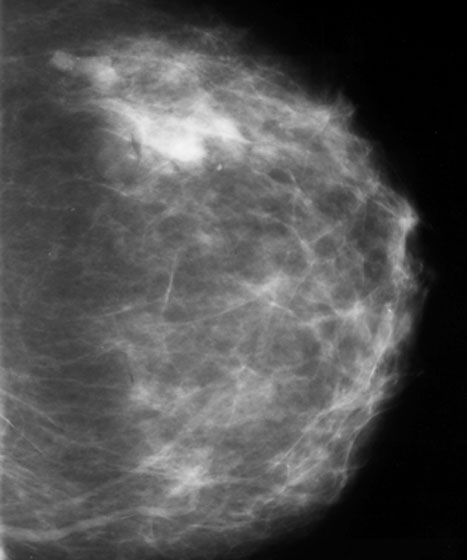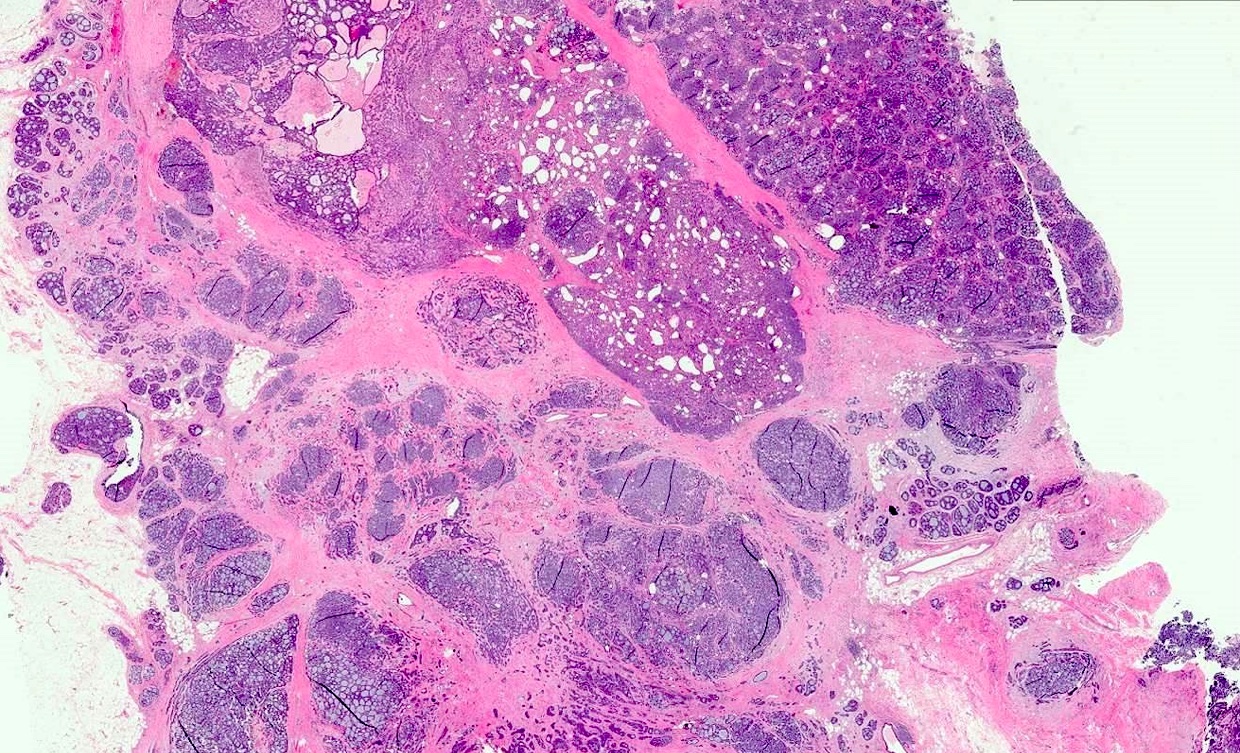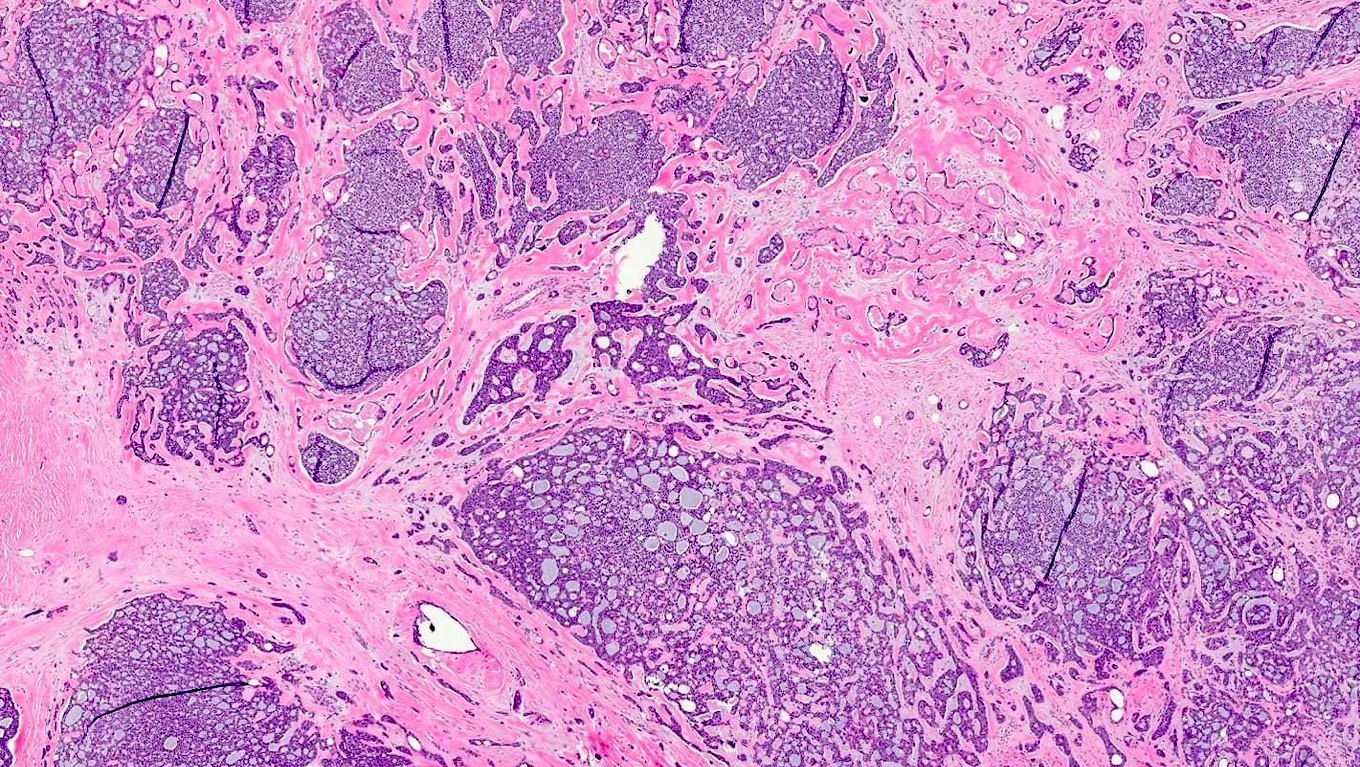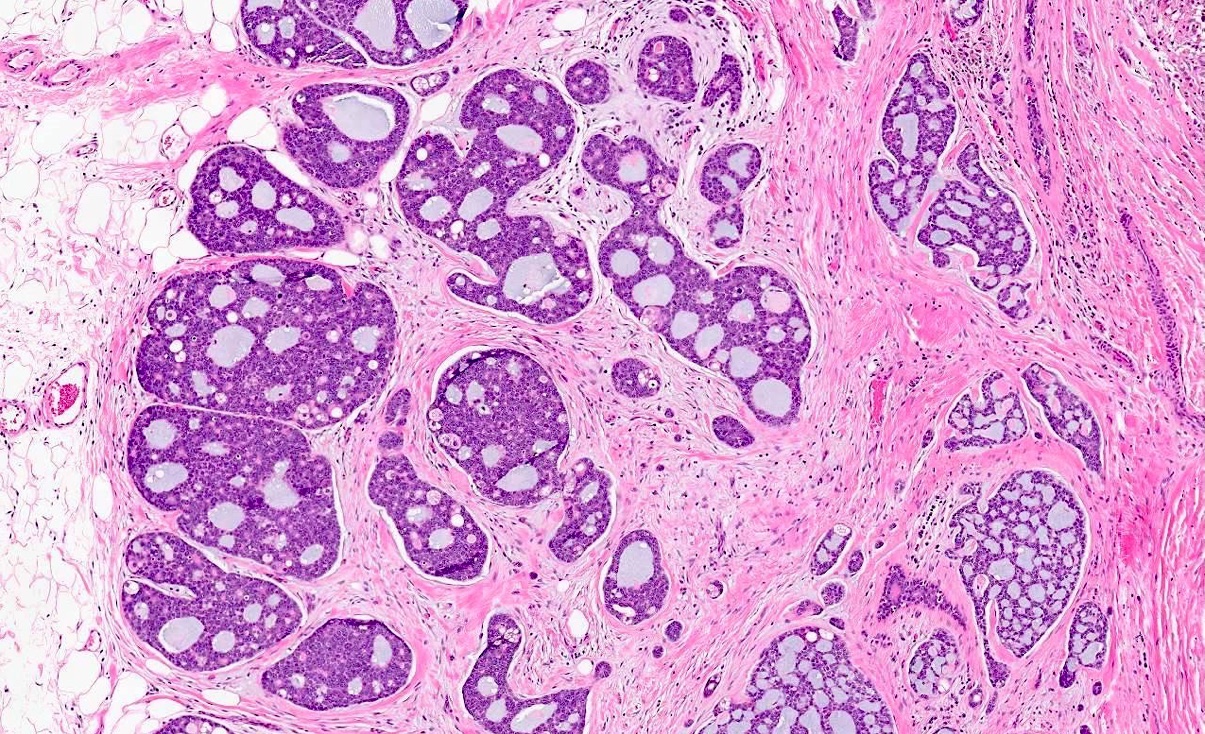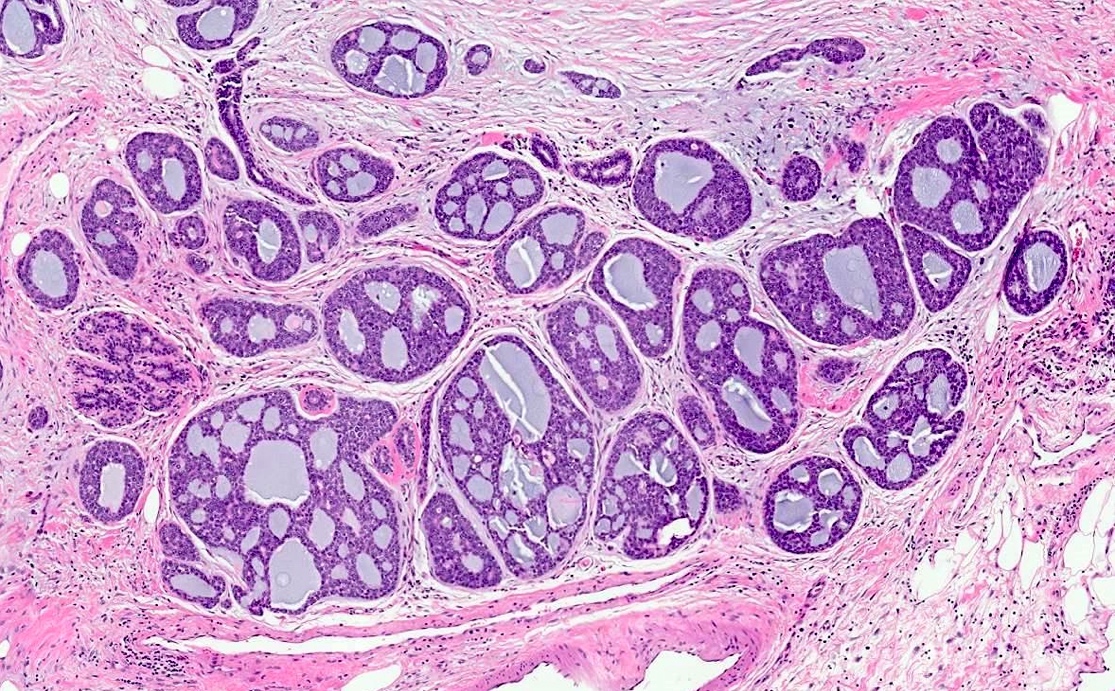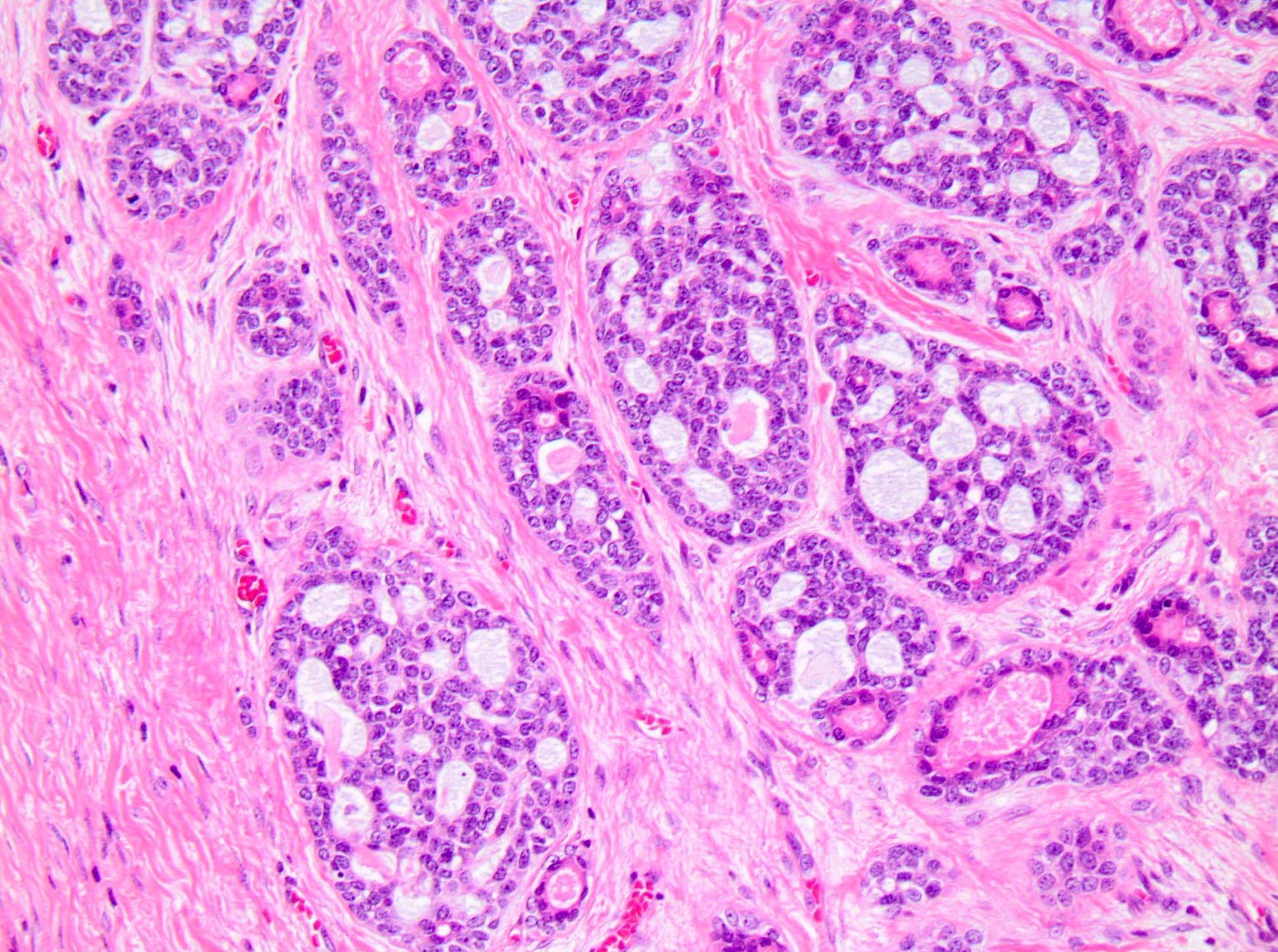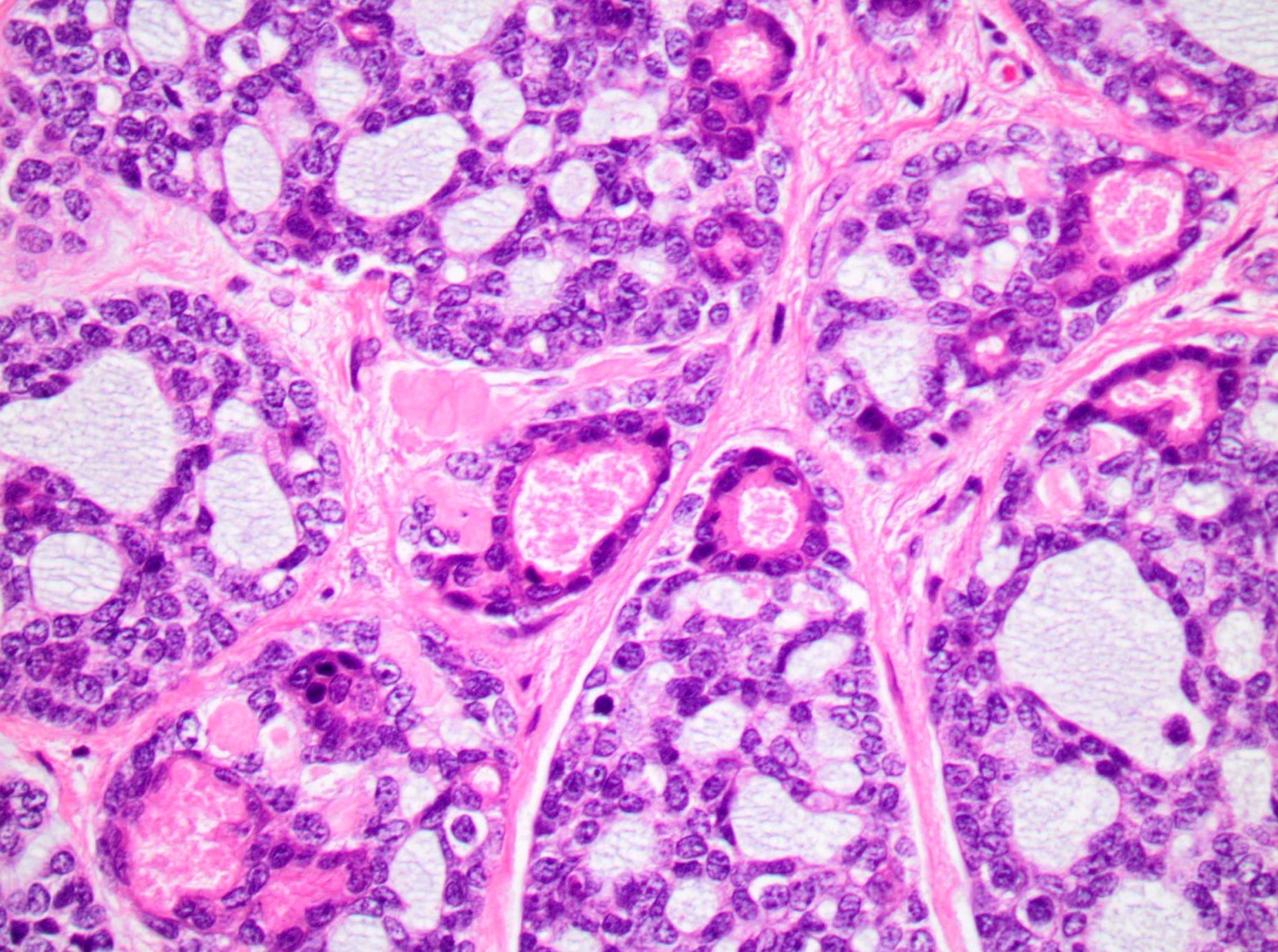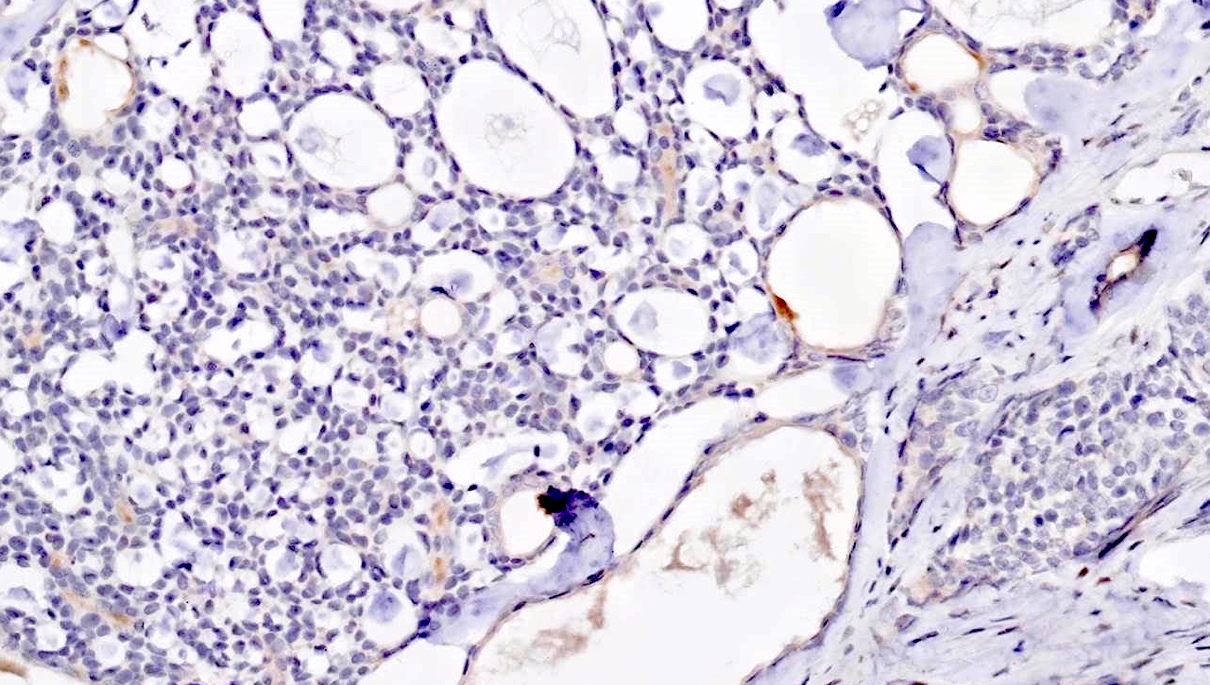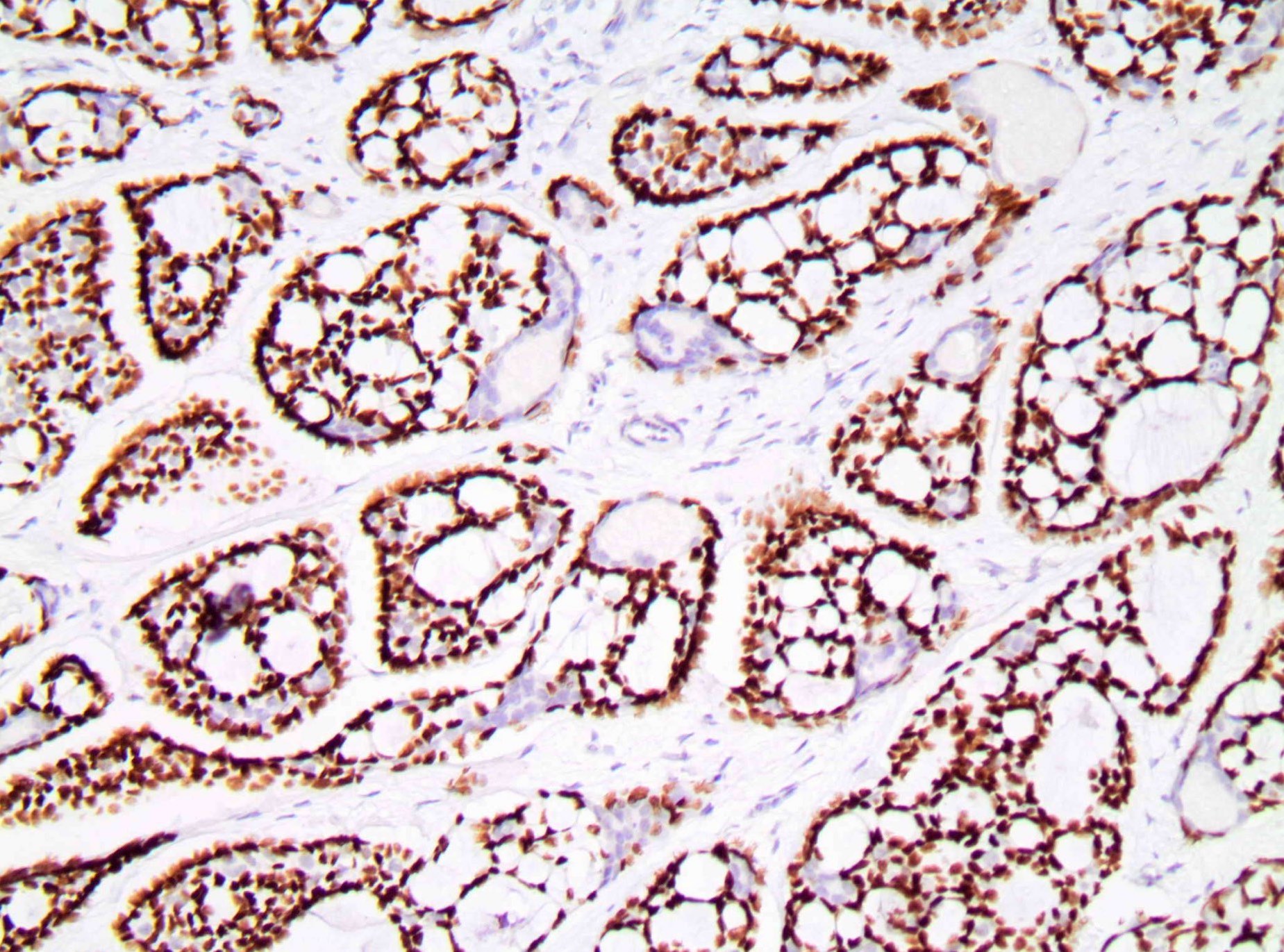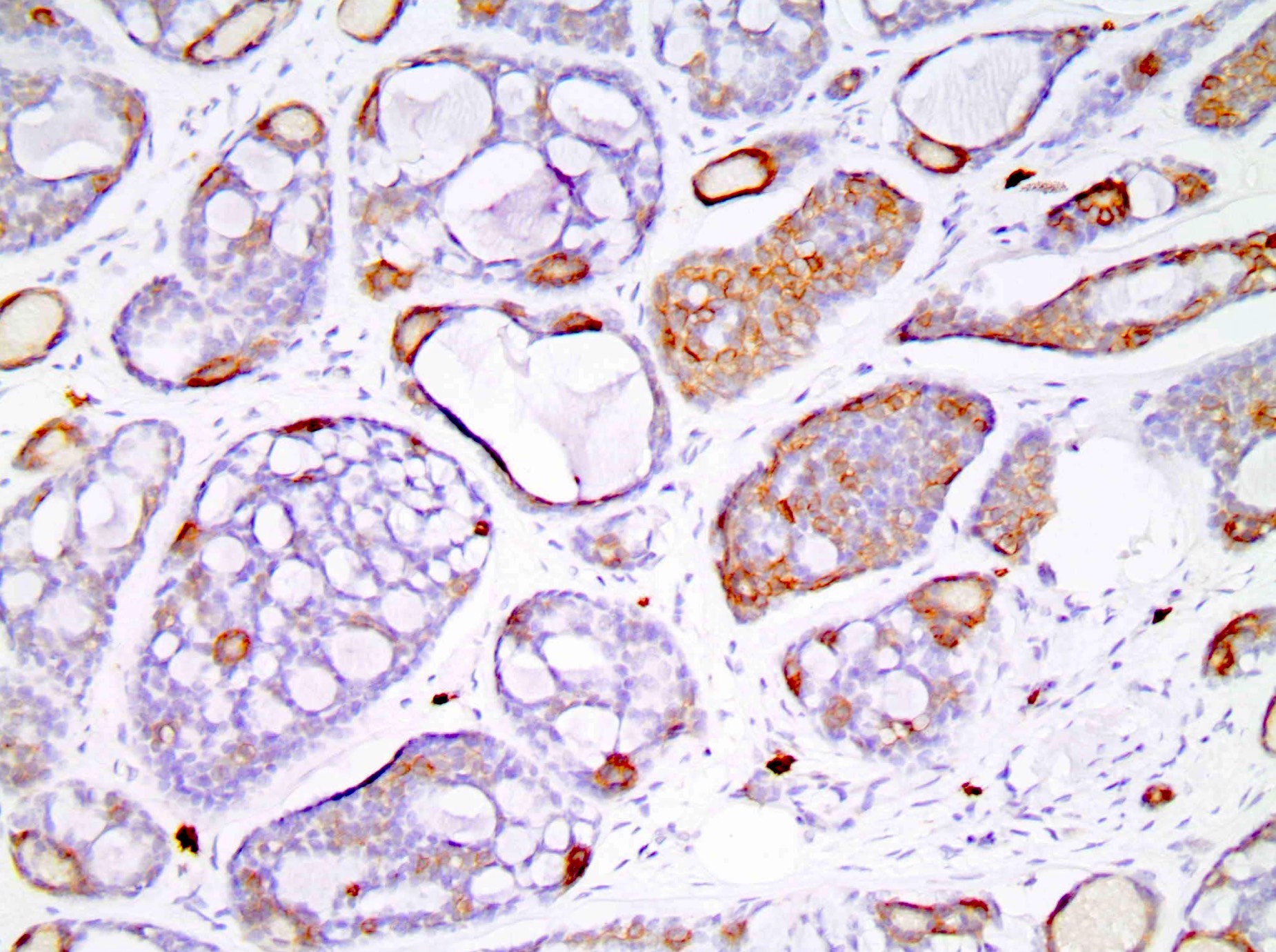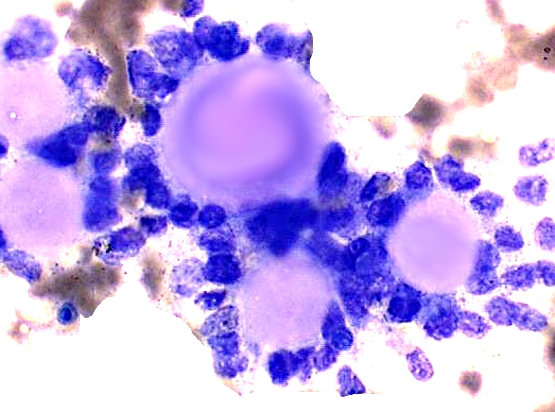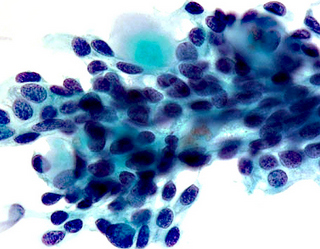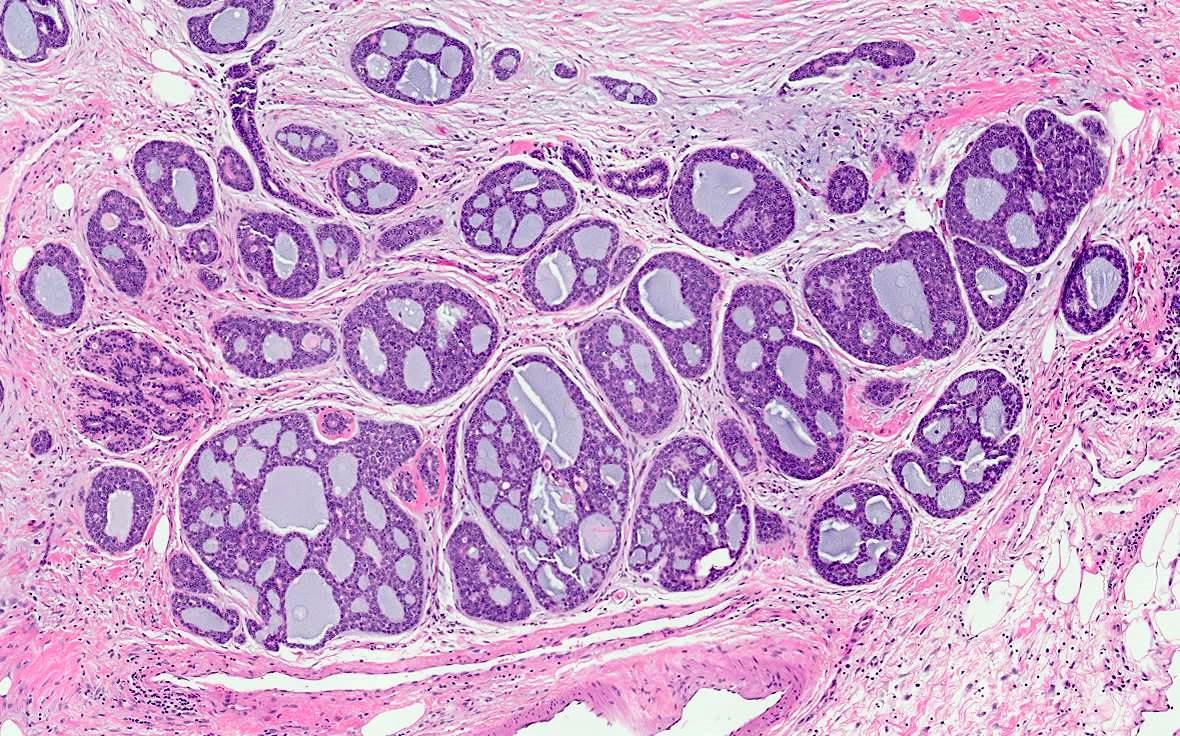Table of Contents
Definition / general | Essential features | ICD coding | Epidemiology | Diagnosis | Radiology images | Prognostic factors | Case reports | Gross description | Microscopic (histologic) description | Microscopic (histologic) images | Cytology description | Cytology images | Positive stains | Negative stains | Molecular / cytogenetics description | Sample pathology report | Differential diagnosis | Additional references | Board review style question #1 | Board review style answer #1 | Board review style question #2 | Board review style answer #2Cite this page: Tozbikian G. Adenoid cystic. PathologyOutlines.com website. https://www.pathologyoutlines.com/topic/breastmalignantadenoidcystic.html. Accessed April 23rd, 2024.
Definition / general
- Histologically similar to salivary gland counterpart
- Triple negative and basal-like subtype of mammary carcinoma with excellent long term survival
Essential features
- Rare subtype of breast cancer, histomorphologically identical to salivary gland counterpart
- Comprised of epithelial and myoepithelial cells arranged in solid, cribriform or tubular arrangements and associated basement membrane material
- Associated with MYB::NFIB fusion
ICD coding
- ICD-10: C50.91 - malignant neoplasm of breast of unspecified site, female
Epidemiology
- Rare, 0.1% of breast carcinomas (Am J Surg 2002;183:646)
- Mean age: 64 years; range: 25 - 80 years (Breast Cancer Res 2010;12:R54)
- May be associated with microglandular adenosis (Am J Surg Pathol 2003;27:1052)
Diagnosis
- Mammogram or other imaging detects a mass
- Diagnosis made by tissue biopsy or resection, often utilizing immunohistochemistry
Prognostic factors
- Low rates of recurrence and better long term outcome compared with ductal NOS type (Breast 2012;21:124, Breast Cancer Res Treat 2004;87:225, Breast Cancer Res 2010;12:R54, J Clin Pathol 2010;63:220)
- High rates of margin positivity (Am J Clin Oncol 2010;33:28)
- Axillary nodal metastases are rare, more frequently seen in the solid variant (Am J Surg Pathol 2002;26:413)
- Treatment is excision with clear margins and possibly radiation; axillary dissection may not be necessary (J Surg Oncol 2010;102:342, Breast 2017;31:214)
Case reports
- 21 year old man with left nipple swelling (Breast J 2020;26:502)
- 56 year old woman with a breast mass (Case Rep Oncol 2019;12:698)
- 63 year old woman with a breast mass (J Surg Case Rep 2019;2019:rjy355)
- 65 year old woman with a breast mass, metastases to lung, kidney and brain (J Med Case Rep 2017;11:303)
- 69 year old woman with a breast mass (Ann Med Surg (Lond) 2019;43:1)
- 71 year old woman with a breast mass (Int J Surg Case Rep 2018;42:196)
- 85 year old woman with a breast mass (J Med Invest 2018;65:289)
Gross description
- 1 - 3 cm, well circumscribed, firm
- May have cystic cut surface
- Reference: Pathology 2017;49:215
Microscopic (histologic) description
- Dual population of cells (Arch Pathol Lab Med 1986;110:1045):
- Luminal / ductal epithelial cells with variable glandular / squamous / sebaceous differentiation
- Myoepithelial / basaloid cells
- Cribriform, solid, tubular or trabecular architectural patterns
- 2 types of lumens that are lined by 2 cell types
- True glandular lumina lined by luminal / ductal epithelial cells (low molecular weight cytokeratin+, CK7+)
- Pseudolumens containing eosinophilic cylinders comprised of basement membrane material (laminin and collagen IV positive) lined by myoepithelial / basal type cells (p63 / p40+, smooth muscle myosin+, calponin+, high molecular weight cytokeratin+, S100+)
- Histologic variants
- Classic variant: most frequent variant, low to intermediate nuclear grade, composed of mixture of 3 different architectural patterns (tubular, cribriform and solid) (Diagn Histopathol 2022;28:142)
- Solid - basaloid variant: solid nests, increased mitotic rate, presence of necrosis, Ki67 > 30%, prominent basaloid features with more aggressive clinical course (Am J Surg Pathol 2002;26:413, APMIS 1999;107:762, BMJ Case Rep 2011;2011:bcr0820114692, Int J Surg Pathol 2016;24:97)
- Adenoid cystic carcinoma with high grade transformation: associated with different higher grade component subtypes such as invasive breast cancer of NST type (Int J Surg Pathol 2011;19:230)
Microscopic (histologic) images
Cytology description
- Clusters of epithelial cells oriented around solid spheres of basement membrane material
Cytology images
Positive stains
- Luminal / ductal epithelial cells
- Basaloid / myoepithelial type cells
- Secretions in true lumina
- PAS+ diastase resistant
- Cribriform spaces
- Pseudolumen secretions
- Laminin
- Collagen IV
Negative stains
Molecular / cytogenetics description
- MYB::NFIB fusion gene (t(6;9)(q22-23;p23-24)) identified in the majority adenoid cystic carcinomas of breast, as well as in solid variant (J Pathol 2012;226:84, Proc Natl Acad Sci U S A 2009;106:18740, Hum Pathol 2014;45:2270)
- Molecular profiling of adenoid cystic carcinomas assign them to the basal-like subtype but have lower genetic instability and copy number aberrations compared with metaplastic, medullary and basal-like no special type (NST) tumors (Breast Cancer Res Treat 2013;142:257, Histopathology 2013;62:543, J Pathol 2008;216:141)
- Solid - basaloid variant: NOTCH and CREBB mutations (Mod Pathol 2020;33:1041)
Sample pathology report
- Left breast, mass 10:00, ultrasound guided core needle biopsy:
- Adenoid cystic carcinoma, 1.2 cm in greatest length (see comment)
- Estrogen receptor: negative (0%, no intensity)
- Progesterone receptor: negative (0%, no intensity)
- HER2: negative (score 0)
- Comment: Additional immunohistochemical stains show that the tumor is positive for CD117, MYB and p40 (in basaloid cells), supporting the diagnosis.
Differential diagnosis
- Collagenous spherulosis:
- Noninfiltrative proliferation of myoepithelial cells enclosing basement membrane material confined within preexisting ducts / lobules and lacking epithelial cell component
- Lacks dual cell population
- Calponin+, smooth muscle myosin heavy chain / SMMHC+, CD117 / KIT- (Mod Pathol 2006;19:1351)
- Invasive cribriform carcinoma:
- Infiltrative glands lack circumscription by myoepithelial cells (myoepithelial cells limited to periphery of ducts involved by ductal carcinoma in situ component)
- Lacks dual cell population
- Estrogen receptor+, progesterone receptor+, CD117 / KIT-
Additional references
Board review style question #1
A 55 year old woman undergoes an excision for a 3 cm breast mass (histologic image of the tumor is shown above). Which statement is true regarding this tumor?
- CD117 / KIT expression is present in the luminal / ductal epithelial cell component
- Frequently shows regional lymph node metastases
- Recurrent t(12;15)(p13;q25) translocation resulting in ETV6::NTRK3 gene fusion is commonly seen
- Represents ~5% of all mammary cancers
- Triple negative for ER / PR / HER2 and has an aggressive clinical course
Board review style answer #1
A. CD117 / KIT expression is present in the luminal / ductal epithelial cell component. The excision shows an adenoid cystic carcinoma, which is a rare subtype of mammary carcinoma representing < 1% of breast cancers. Despite triple negative status, these tumors generally show excellent long term survival. Similar to the salivary gland counterparts, adenoid cystic carcinomas of the breast are characterized by t(6;9)(q22-23;p23-24) translocation resulting in a MYB::NFIB fusion gene. The t(12;15)(p13;q25) translocation resulting in ETV6::NTRK3 gene fusion (answer C) is seen in secretory carcinoma of the breast. Consistent CD117 / KIT protein expression is observed in most adenoid cystic carcinomas of the breast; however, underlying KIT gene alterations have not been identified (Histopathology 2013;62:543).
Comment Here
Reference: Adenoid cystic carcinoma
Comment Here
Reference: Adenoid cystic carcinoma
Board review style question #2
Which immunohistochemical stain finding is typically observed in adenoid cystic carcinoma of the breast?
- CD117 / KIT negative, estrogen receptor negative
- CD117 / KIT positive, estrogen receptor positive
- CD117 / KIT positive, HER2 positive
- MYB positive, estrogen receptor negative
- MYB positive, HER2 positive
Board review style answer #2
D. MYB positive, estrogen receptor negative. Adenoid cystic carcinoma of the breast is a biphasic tumor comprised of a ductal / epithelial cell and myoepithelial / basaloid cell components. The ductal / epithelial cells are immunoreactive for low molecular weight keratins such as CK7 and CK8/18. The myoepithelial / basaloid cell component is positive for high molecular weight keratins (CK5/6, CK14, CK17) and myoepithelial markers (p40 / p63, SMMS, calponin). Additionally, mammary adenoid cystic carcinomas generally express CD117 / KIT and MYB, and are triple negative for estrogen receptor, progesterone receptor and HER2.
Comment Here
Reference: Adenoid cystic carcinoma
Comment Here
Reference: Adenoid cystic carcinoma




